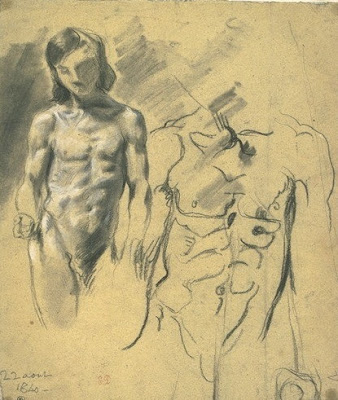 |
| Eugène Delacroix Study of Hand ca. 1825 drawing Musée du Louvre |
 |
| Eugène Delacroix Study of Hands ca. 1840 drawing Musée du Louvre |
 |
| Eugène Delacroix Study of Arm 1855 drawing Musée du Louvre |
 |
| Eugène Delacroix Study of Back ca. 1850 drawing Musée du Louvre |
 |
| Eugène Delacroix Académie ca. 1820-22 drawing Musée du Louvre |
 |
| Eugène Delacroix Académie ca. 1820-22 drawing Musée du Louvre |
 |
| Eugène Delacroix Sheet of Studies ca. 1820-22 drawing Musée du Louvre |
 |
| Eugène Delacroix Sheet of Studies ca. 1820-22 drawing Musée du Louvre |
 |
| Eugène Delacroix Écorché Studies ca. 1850 drawing Musée du Louvre |
 |
| Eugène Delacroix Écorché Studies ca. 1850 drawing Musée du Louvre |
 |
| Eugène Delacroix Écorché Studies ca. 1850 drawing Musée du Louvre |
 |
| Eugène Delacroix Sheet of Studies 1840 drawing Musée du Louvre |
 |
| Eugène Delacroix Sheet of Studies ca. 1860 drawing Musée du Louvre |
 |
| Eugène Delacroix Study of Pelvic Bones ca. 1825 drawing Musée du Louvre |
 |
| Eugène Delacroix Study of Pelvic Bones ca. 1825 drawing Musée du Louvre |
"Moreover there are several kinds of drawings, as there are of colour: the exact or silly, the physiognomic and the imaginative. The first is negative, incorrect by sheer force of reality, natural but absurd; the second is naturalistic, but idealized draughtsmanship – the draughtsmanship of a genius who knows how to choose, arrange, correct, rebuke, and guess at nature; lastly the third, which is the noblest and strangest, and can afford to neglect nature – it realizes another nature, analogous to the mind and the temperament of the artist. Physiognomic drawing is generally the domain of the fanatical, like M. Ingres; creative drawing is the privilege of genius. The great quality of the drawing of supreme artists is truth of movement; and Delacroix never violates this natural law."
– from The Salon of 1846, published in Art in Paris, 1845-1862: Salons and Exhibitions reviewed by Charles Baudelaire, translated and edited by Jonathan Mayne (London: Phaidon Press, 1965)